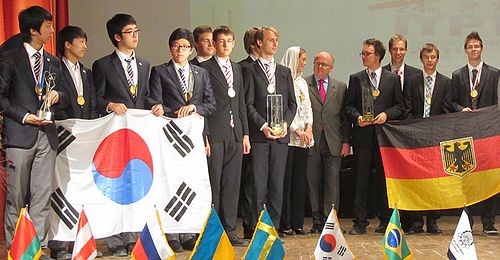From IYPT
IYPT 2011 in Tehran, Iran
Local Website: http://iypt.ir/
Results
Finals
| Place | Team | Points |
|---|---|---|
| 1 | Korea | 51.3 |
| 2 | Austria | 46.2 |
| 3 | Germany | 45.4 |

Total ranking of all teams after round 5, including the finals
Rank Team Name Score 1 [16] Korea 281.5 2 [14] Austria 254.4 3 [19] Germany 250 4 [5] Chinese Taipei 203.1 5 [21] Iran 202.8 6 [7] Slovakia 201.8 7 [1] Singapore 198.5 8 [12] Belarus 197.8 9 [6] Sweden 191.8 10 [8] Poland 190.6 11 [9] Croatia 186.1 12 [3] Georgia 185.5 13 [20] Czech Republic 183 14 [2] Bulgaria 177.3 15 [10] Brazil 175.6 16 [13] Switzerland 174.7 17 [18] China 172.1 18 [11] Russia 168.3 19 [17] Thailand 164.1 20 [15] Kenya 136 21 [4] Ukraine 135.7
Problems
Printer-friendly PDF version.
1. Adhesive tape
Determine the force necessary to remove a piece of adhesive tape from a horizontal surface. Investigate the influence of relevant parameters.
2. Air drying
Table utensils (dishes, cutlery, etc.), after being washed, dry differently. Investigate how the time of drying depends on relevant parameters.
3. Bouncing flame
Place a flame (e.g. from a Bunsen burner) between two charged parallel metal plates. Investigate the motion of the flame.
4. Breaking spaghetti
Find the conditions under which dry spaghetti falling on a hard floor does not break.
5. Car
Build a model car powered by an engine using an elastic air-filled toy-balloon as the energy source. Determine how the distance travelled by the car depends on relevant parameters and maximize the efficiency of the car.
6. Convection
In a container filled with a liquid, heat transport will occur when the bottom of the container is heated and the top surface is cooled. How does the phenomenon change when the container rotates about its vertical axis?
7. Cup drum
A plastic cup is held upside-down and tapped on its base. Investigate the sound produced when the open end of the cup is above, on or below a water surface.
8. Domino amplifier
A row of dominoes falling in sequence after the first is displaced is a well known phenomenon. If a row of "dominoes" gradually increases in height, investigate how the energy transfer takes place and determine any limitations to the size of the dominoes.
9. Escaping powder
When a hot wire is plunged into a beaker of water with powder (e.g. lycopodium) floating on the surface, the powder moves rapidly. Investigate the parameters that alter the speed of movement of the powder.
10. Faraday heaping
When a container filled with small spheres (e.g. mustard seeds) is vibrated vertically with a frequency between 1 – 10 Hz, so called Faraday heaping occurs. Explore this phenomenon.
11. Fingerprints
Fill a glass with a liquid and hold it in your hands. If you look from above at the inner walls of the glass, you will notice that the only thing visible through the walls is a very bright and clear image of patterns on your fingertips. Study and explain this phenomenon.
12. Levitating spinner
A toy consists of a magnetic spinning top and a plate containing magnets (e.g."Levitron"). The top may levitate above the magnetic plate. Under what conditions can one observe the phenomenon?
13. Light bulb
What is the ratio between the thermal energy and light energy emitted from a small electric bulb depending on the voltage applied to a bulb?
14. Moving cylinder
Place a sheet of paper on a horizontal table and put a cylindrical object (e.g. a pencil) on the paper. Pull the paper out. Observe and investigate the motion of the cylinder until it comes to rest.
15. Slow descent
Design and make a device, using one sheet of A4 80 gram per m² paper that will take the longest possible time to fall to the ground through a vertical distance of 2.5m. A small amount of glue may be used. Investigate the influence of the relevant parameters.
16. Smoke stream
A glass jar is covered with cellophane. A tightly folded paper tube of length 4-5 cm is inserted hermetically into the jar through the cellophane cover. The tube is oriented horizontally. If one burns the outside end of the tube the dense smoke flows into the jar. Explore this phenomenon.
17. Vikings
According to a legend, Vikings were able to navigate in an ocean even during overcast (dull) weather using tourmaline crystals. Study how it is possible to navigate using a polarizing material. What is the accuracy of the method?
References
Below, find a list of links to further reading material concerning the problems. This material is provided by independent persons or organizations, for the benefit of everyone who is interested. If you want your material listed here, contact the Executive Committee.
The IYPT wants to stress that any information found on any of these sites is in no way authoritative. The IYPT does not endorse any of this material whatsoever. Furthermore, we kindly remind all readers that the IYPT guidelines clearly stand for standard scientific conduct and proper procedures for citing material that is not one's own work, while the grading has a focus on the novelty and consistency of the original research results presented.
- Set of references, questions and advices for 24th IYPT by Ilya Martchenko
